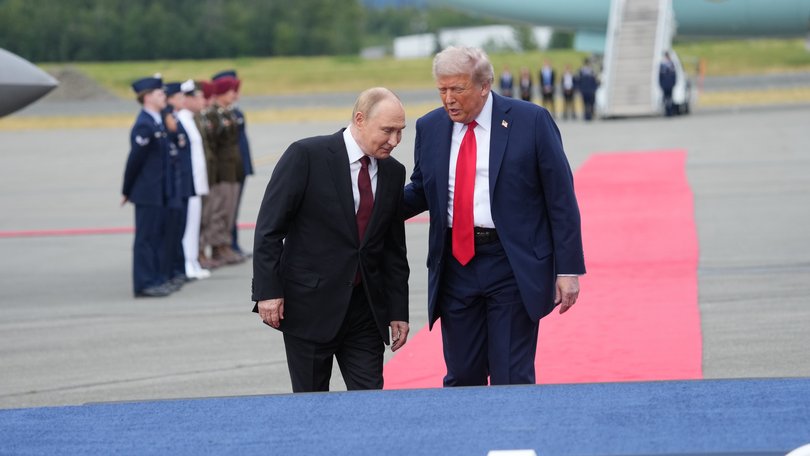THE NEW YORK TIMES: A timeline of Trump’s complicated relationship with Putin

President Donald Trump’s posture toward President Vladimir Putin of Russia over the last two decades or so has veered from admiring to infuriated, cozy to detached, so it was unclear which approach he would take at the Alaska meeting.
This would be at least their seventh known face-to-face encounter and the first of Trump’s second term. Here’s a look at some of the past meetings and what the two have said about each other over the years:
The Early Years
Sign up to The Nightly's newsletters.
Get the first look at the digital newspaper, curated daily stories and breaking headlines delivered to your inbox.
By continuing you agree to our Terms and Privacy Policy.In 2007, after Time magazine selected Putin as its “Man of the Year,” Trump wrote him a congratulatory letter. “As you probably have heard, I’m a big fan of yours!” Trump wrote.
Six years later, Trump took the Miss Universe contest to Moscow. Months before the pageant, which he owned at the time, he wondered on social media if Putin would attend, and if so, “will he become my new best friend?”
Putin did not attend.
The 2016 Presidential Campaign
Soon after he formally announced a run for the White House in 2015, Trump told reporters in July that he would “get along very well with Vladimir Putin.”
The exchange of compliments continued that year, when Putin called Trump “a very bright and talented man,” and Trump said that praise was a “great honor.”
In July 2016, though, Trump seemed to backtrack after saying repeatedly for years that he had a relationship with Putin. “He said one nice thing about me. He said I’m a genius. I said thank you very much to the newspaper, and that was the end of it. I never met Putin,” he said.
During the final presidential debate in 2016, Hillary Clinton suggested that he would be Putin’s “puppet,” which Trump dismissed. But questions over Trump’s ties to Russia did not go away, and after he took office in January 2017, Russia’s role in the U.S. election dominated political conversation in the United States.
A U.S. intelligence assessment made public that month concluded that Putin had ordered an operation to interfere in the election in an effort to “undermine public faith in the U.S. democratic process, denigrate Secretary Clinton and harm her electability and potential presidency.” Russia, the assessment said, had “developed a clear preference for” Trump.
Trump denied wrongdoing and attacked the investigation.
The First Meetings
The first in-person meetings between the two leaders took place at the Group of 20 summit in Hamburg, Germany, where Trump asked Putin about Russian interference in the election. Putin denied any involvement. After the meeting, Trump took his interpreter’s notes and instructed him not to brief anyone. They spoke again at a dinner during that summit.
They met again in November that year, in Vietnam, and in July 2018 in Helsinki. On both occasions, Putin denied interfering in the 2016 election. In Helsinki, Trump stood beside Putin and challenged the conclusion of his own intelligence agencies about Russian election interference.
Later in 2018, the two leaders spoke informally at dinner during a G20 meeting in Argentina. Little information emerged about that discussion.
They met once more before the end of the first Trump term, at the G20 summit in Osaka, Japan, in June 2019. By then, special counsel Robert Mueller had concluded that Russian had carried out a “sweeping and systematic” attack on U.S. democracy.
Asked by a reporter whether he would tell Russia not to meddle in U.S. elections, Trump said, “Yes, of course, I will.” He then turned to Putin, with a half-grin, and said, “Don’t meddle in the election, President,” as Putin chuckled.
Russian Invasion of Ukraine
In February 2022, as Russia prepared to invade Ukraine, Trump, now out of the White House, called Putin “pretty smart” during a fundraiser.
“He’s taken over a country for $2 worth of sanctions,” Trump said, “taking over a country — really a vast, vast location, a great piece of land with a lot of people — and just walking right in.”
The next year, as he revved up another presidential campaign, Trump said he would end the war in Ukraine “before I even arrive at the Oval Office.”
Trump’s Second Term
As he began his second term, Trump expressed an interest in swiftly bringing an end to the war in Ukraine. But his relationship with President Volodymyr Zelenskyy of Ukraine took a nosedive in February after a fiery confrontation at the White House.
Trump and Vice President JD Vance berated Zelenskyy for not showing more gratitude for U.S. support, and the president said that Putin had “been through a lot with me” in enduring the “Russia hoax” — Trump’s description of the investigation into Russian election interference in 2016.
But Trump began to indicate frustration with Putin as the war proved harder to end than he had expected. “I’m not happy with Putin — I can tell you that much right now — because he’s killing a lot of people,” Trump said in July.
He appeared to soften his comments before the meeting in Alaska, saying he “got along well” with Putin. He said he would know within minutes of speaking with the Russian leader Friday if he would strike a deal to end the war.
This article originally appeared in The New York Times.
© 2025 The New York Times Company
Originally published on The New York Times
